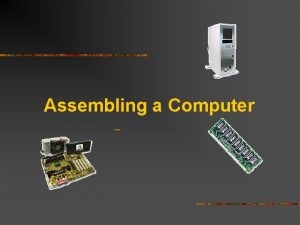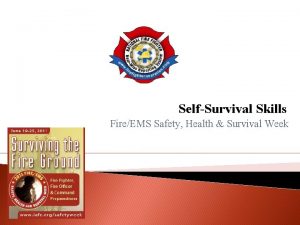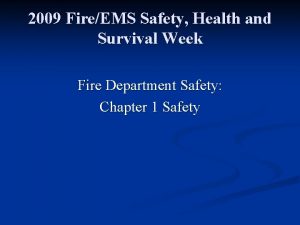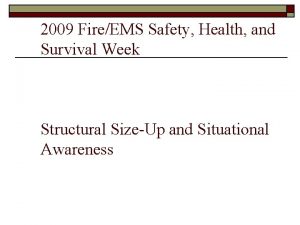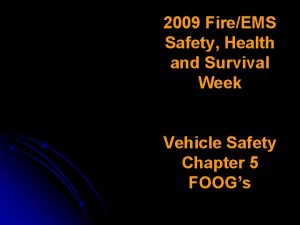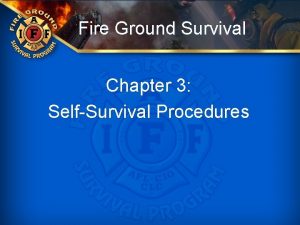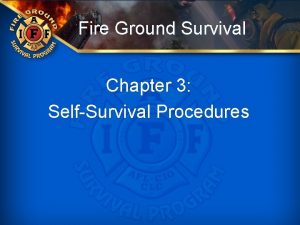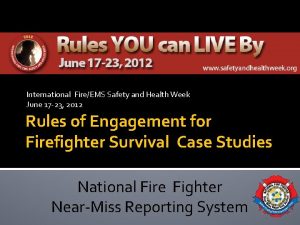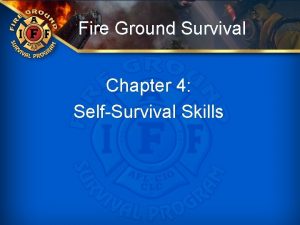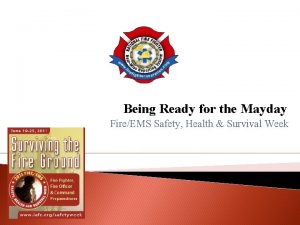SelfSurvival Procedures FireEMS Safety Health Survival Week SelfSurvival










- Slides: 10

Self-Survival Procedures Fire/EMS Safety, Health & Survival Week

Self-Survival Procedures � Firefighters/EMTs can increase their self-survival procedures by reviewing the following topics: ◦ Avoid Panic ◦ Mnemonic Learning Aids such as “GRAB-LIVES” ◦ Emergency Breathing � By following key points in the proceeding slides, and their associated Near-Miss Reports, Firefighters/EMTs can be better increase their “Self-Survival Procedures”

Avoid Panic � Although easier said than done, it is crucial for a Firefighter/EMT to attempt to remain calm and revert back to their training when in a Mayday situation. � Panic is the result of a sudden, overwhelming terror or condition that leads to an increased heart rate, air consumption, and altered level of thinking/situational awareness. � Remain calm, take deep breaths, and follow emergency procedures dictated by the situation that you are in.

Avoid Panic Near-Miss Report 09 -400 “…At the third floor, the crew found smoke exiting from under a closed bedroom door. The officer opened the door to find fire and heavy smoke. One of the crew members quickly realized that he forgot to place his regulator into his mask. With the hallway quickly filling with smoke, the member struggled to make the connection. He was unable to make the connection and began to panic. He turned and left the crew without telling the other members. He made his way outside to fresh air. He was able to connect his regulator and returned to the crew inside. ”

Mnemonic Learning Aids: ”GRAB-LIVES” � Mnemonics assist Firefighters/EMTs in learning live saving techniques in an easy to understand way. � Studies on mnemonics have shown spectacular recall abilities by users of the devices. G-Gauge-Check your air R-Radio-Mayday given on Radio A-Activate your PASS B-Breathe-Control your breathing L- Low. Stay low to the ground I- Illuminate. Shine your light V- Volume. Make noise E- Exit. Search for an exit. S- Shield. As a last resort, with no air, remove your regulator and shield your airway to filter the smoke.

Mnemonics: “GRAB-LIVES” Near-Miss Report 10 -277 “…Part way up the stairs, he completely ran out of air. In a condition of "high motivation, ” he started to hurry. Staying low and following the hoseline, he became disoriented and ended up reversing his direction. He then fell back down the stairs, knocking his face piece off. The conditions were still untenable. He repositioned his face piece so his Nomex hood would give him some filtering action. He then activated his PASS device and activated the emergency button on his radio. He stated that he was unable to speak due to the heavy smoke conditions”.

Emergency Breathing � In the event that a Firefighter/EMT is out of air and needs to perform some sort of emergency breathing, proper training and understanding of such is crucial in the outcome of the event. � Don’t let an emergency situation be the first time you attempt an emergency breathing exercise-TRAIN. � Emergency breathing includes buddy breathing, skip- breathing & other techniques, equalizing tanks, etc.

Emergency Breathing Near-Miss Report 05 -478 “…A few moments passed and I felt the last breath come through my air line… Iturned and crawled to where I thought the exit was, back and to my left, and found myself in a small space; definitely not the exit. I had now exhausted the air in my tank and face piece, and was using a dive technique of rapid breathing to redistribute the air in my lungs. I back crawled a few feet, moved left thinking the line was in the room and thus a way out, but found nothing as the line was pulled back with the crew in the hall. I stopped, dropped my face to the floor, cracked the chin of my mask, took a shallow breath, and said, “I’m out of air”…”

Activities � Activity 1: “GRAB-LIVES” ◦ Have a Firefighter/EMT follow a hose line into a room with a blacked-out face piece or backwards hood. Constrain the member in a way that will not injury him/her. The firefighter/EMT should at this point go through a Mayday procedure, specifically by following the “GRAB-LIVES” mnemonic.

Activities � Activity 2: Conserving Air ◦ This activity is rather simple but can require up to 1 hour of time. Have member bleed several SCBA cylinders down to ¼ capacity. ◦ For one evolution, have members pulling hose lines, climbing stairs, and other physical events. Note the time it takes to deplete the tank to the point that the mask begins sucking to the face. ◦ For the 2 nd evolution, again starting at ¼ capacity, have members in a resting position breathing at a normal, controlled, rate and observe the time it takes to deplete the tank. ◦ This exercise demonstrates how by attempting to remain calm and conserve air, a rather large amount of time can be added to your available air, allowing others to find you in a Mayday situation. Photos courtesy of the IAFC Photo Contest”
 State of survival survival of the fittest tweak
State of survival survival of the fittest tweak State of survival survival of the fittest stages
State of survival survival of the fittest stages Week by week plans for documenting children's development
Week by week plans for documenting children's development Chapter 10 workplace safety procedures
Chapter 10 workplace safety procedures Computer safety procedures
Computer safety procedures Implement food safety procedures
Implement food safety procedures Implement food safety procedures
Implement food safety procedures Where do you activate the four shades function
Where do you activate the four shades function Safety care certification
Safety care certification Personal safety vs process safety
Personal safety vs process safety Safety assessment for ind safety reporting
Safety assessment for ind safety reporting




